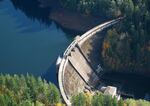In the mornings, Jeff Mastrandea waits a good 30 seconds after turning on his faucet. He also makes sure to drink from a filter. He does this because his water is sometimes laced with unsafe levels of lead. He wants to let any water with the toxic metal drain out before he takes a drink. When the famously pure water from Portland’s Bull Run Watershed sits overnight in the copper plumbing of his 1984 Gresham home, it corrodes the lead solder that fuses those pipes together.

The city of Portland has two drinking water reservoirs in the Bull Run watershed.
Cassandra Profita / OPB/EarthFix
Mastrandea has lived in the house for decades. His daughter grew up there. He’s learned about the lead issue only more recently, when his home became one that city officials test regularly for lead and copper.
“It’s hard to know what kind of risk was happening,” Mastrandea said. “I think we all should be concerned with the quality of our water and the trust that we place in our government to provide us with that.”
A conversation with Portland Water Bureau Director Mike Stuhr
A new analysis from the Associated Press shows that Portland is the biggest water system in the country that’s tested above the limit for lead since 2013. To help understand what that means, OPB All Things Considered host Kate Davidson spoke with Mike Stuhr, director of the Portland Water Bureau.
Taps in Portland – and the several metro area water districts that buy its water – have been found to have too much lead on ten different occasions since the federal agency began enforcing its lead and copper rule in 1991, according to an analysis of federal data released this week by the Associated Press. The EPA requires treatment systems to take action when tests find lead above 15 parts per billion, but no safe level of exposure for children exists. Lead in a child's blood can cause a host of health issues, including behavioral changes, lowered IQ and stunted development. Since 2013, at least 67 systems tested throughout Oregon, Washington and Idaho have been found to have too much lead to meet EPA standards. Most are small systems, serving only a few hundred to a thousand people. Fifteen of those are systems serving schools and childcare centers.
Portland's is far and away the largest drinking water system in the country to test high for lead since 2013, according to the data. The city has no lead distribution pipes and spent $10 million removing lead connections in the late 1990s. Only a fraction of its customers are at risk of lead in drinking water: those with lead solder or lead-containing fixtures, like brass, in their plumbing. Years ago, regulators at the Portland Water Bureau made a choice that left those thousands of homes like Mastrandea's at risk of lead contamination above the limit set by the federal government.
Related: Schools In Oregon, Idaho And Washington Report Higher Lead
Ultimately, they think the decision helped reduce people's exposure to lead. "It is possible that further additions, chemicals, could reduce the amount of lead in water," Scott Bradway, a water quality manager with the Portland Water Bureau, said. "But we made a conscious decision that instead of putting in additional chemicals to our water, we would spend our energy focused on the other sources of lead." Portland's source water is as good as advertised. But there are drawbacks to the city's hands-off approach to chemically treating it: the failure to use additives that reduce corrosion in household water pipes means residents themselves have to be on alert about reducing exposure for them and their children. The water crisis in Flint, Michigan, has turned a spotlight on drinking water protection and lingering sources of lead exposure across the country.
That, coupled with Portland's recent phase-out of its controversial open-air reservoirs, has prompted local and federal officials to revisit the city's hands-off approach to water quality and study its efforts to prevent corrosion. Portland is in the midst of a new corrosion control study, and the EPA recently contacted city officials to review its lead exposure prevention efforts. "EPA now expects that with the decommissioning of these reservoirs, the PWB can complete the work to maximize health protection by reducing lead at consumers' taps to levels as low as feasible," agency spokesman Jeff Philip said.
Why Portland Chose What It Did
When the EPA published new rules for lead in drinking water in 1991, officials with the Portland Water Bureau faced a dilemma. Expert evaluations showed Portland's water supply was unlikely to respond to basic corrosion controls, primarily because of its open reservoirs. The open reservoirs made the water's acidity unpredictable. Basic steps to lower the acidity, like adding compounds like sodium hydroxide, would not be enough to meet federal standards. An additive like orthophosphate, which creates a coating in pipes that prevents corrosion, was also problematic. Against open air, the additive can cause algal blooms that carry their own problems for water quality. There was no guarantee either control would be fully effective, and adding too much of either could put the bureau out of compliance with its wastewater discharge permit. There was another challenge: the customer base. The public's strong preference for keeping Portland's water source pure and natural – in open air reservoirs and free of chemical treatment – hindered efforts that would have reduced the amount of lead in drinking water. Portland remains the largest city in the country that does not add fluoride to its water. The city finally decided to phase out its open-air reservoirs after more than a decade of debate.

Portland Water Bureau's Mt. Tabor Reservoir No. 5
Michael Clapp / OPB
"Portland residents have said pretty clearly that they want a minimal amount of treatment in their water, so that's something that needs to be taken into account" Bradway said. Aggressive chemical treatment might not work. And even if it did, officials feared it would anger a lot of Portlanders. State research also showed children in the metro area were more often poisoned by flaking lead paint in old homes than from drinking water. So regulators tried something different. They chose to treat the water only minimally; they add some sodium hydroxide to raise the pH level of the water and make it less corrosive. That reduced the amount of lead in water by more than 50 percent, but not always enough to meet federal limits. They also publicized easy steps consumers can take on their own to reduce lead levels – like the filtering and tap-running steps Gresham homeowner Jeff Mastrandea follows – which officials say reduce lead levels more than 90 percent. With the money saved by using fewer chemical treatments — about $500,000 a year — they set up a first-of-its-kind lead hazard reduction program focused on raising awareness for all sources of lead exposure. They offer free drinking water tests for homes and free blood lead tests for children, distributed brochures and other literature to customers and staffed a lead poisoning hotline. "I think the results are encouraging, that each year we seem to find a smaller and smaller number of cases of lead poisoning. We continue to investigate them, and we're not finding water as the source," Multnomah County Health Officer Dr. Paul Lewis said.
Praise For Portland's Approach
Portland’s novel approach to lead hazards garnered awards and praise from across the country.
Lisa Ragain, a water planner with the Metropolitan Washington Council of Governments and former Portland resident, has worked on lead and drinking water quality across the country since the early 2000s. She said while most would favor both aggressive chemical treatment to control pipe corrosion and outreach as the ideal approach, she sees a lot of value in what Portland has done. "It is a really good model to look at for doing all the other work you need to do if you've got a challenge with lead in your community," Ragain said. Historically most lead exposure outreach campaigns were run by a local health or housing department and tended not to focus on drinking water, Ragain said. They were also rarely assessed to see who they were actually reaching. Portland's lead hazard program changed both of those.
EPA: We're Not Impressed
It also drew skepticism and criticism from the U.S. Environmental Protection Agency, which has stated that Portland’s approach left it out of compliance with federal rules.
Agency staff have commended the city's outreach efforts but expressed concern that many Portland residents are likely being exposed to lead in drinking water without their knowledge. The EPA says 20 percent of a person's lead exposure comes from drinking water — double or triple that for infants consuming formula. In Oregon, health officials say investigations into cases of lead poisoning have not linked any to drinking water.

Bull Run Dam
Portland Water Bureau
"Certainly lead in drinking water would contribute to the body burden, but in each case where we've investigated, virtually all of those would be lead paint," said Dave Leland, drinking water manager for the Oregon Health Authority, which oversees local treatment systems' compliance with the lead rule. Portland Water Bureau officials say testing shows only 3 percent of homes in its service area have the potential for high levels of lead. The Portland Water Bureau has also faced criticism for its lead water testing. The Washington Post reported in 2004 that, at the EPA's suggestion to expand its testing to suburbs, the utility stopped testing more than half the homes with lead higher than the federal limit and instead, started including in its tests suburban homes that had, on average, significantly lower levels. The Water Bureau said an analysis of homes done before the sampling changes also showed a drop in lead levels, indicating the drop was more a result of corrosion control than of sampling bias.
Correction: April 11, 2016. An earlier version of this story misstated the percent of lead reduced from water by pH adjustment. Adjustment of pH reduced lead by more than 50 percent.
